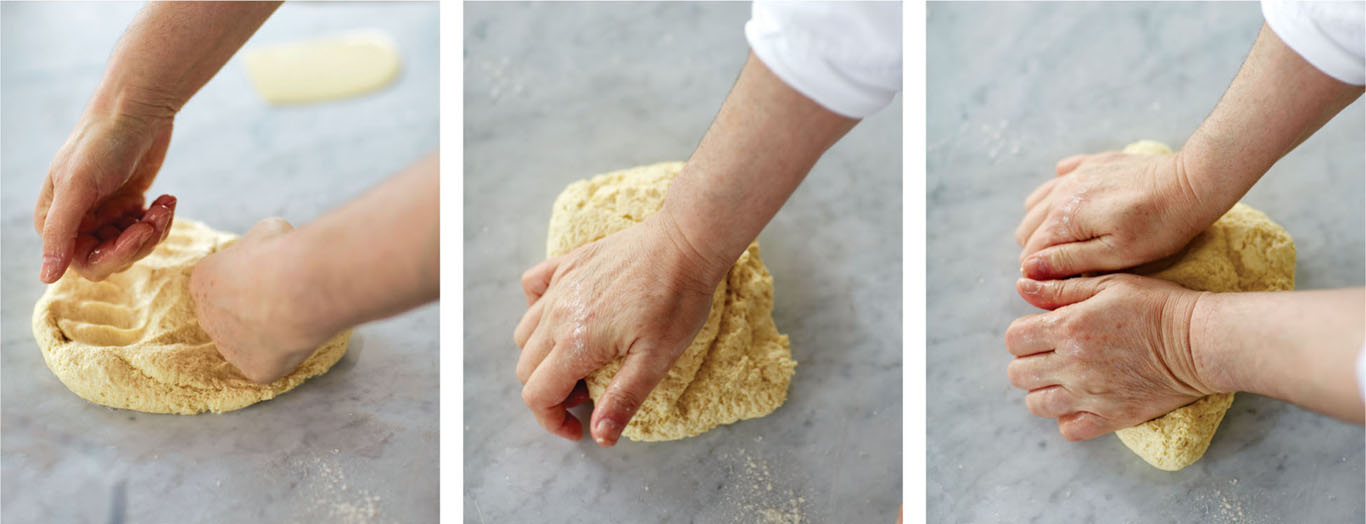K’SRA
MOROCCO

Morocco is one of those rare countries where bakeries are not so much a place where professional bakers bake and sell bread, but rather a resource for the neighborhood: Dough is prepared and proofed at home and the risen loaves taken to the local bakery to bake. Each neighborhood has at least one bakery. The lady of the house will not be the one to take the bread to the bakery, however. She will be too busy cooking the meal at home. Instead it will be one of her offspring or one of the grandparents who will carry out the bread and bring it back home once baked. That moment of the day, just before lunch, when a procession of boys, girls, and old men and women files through the narrow lanes of the medina, each carrying a tray either in their arms or on their head where they have the family’s loaves ready to be taken to the bakery, is quite magical. And if you venture inside a bakery, you will inevitably find the baker feeding the loaves into the hot oven, being careful not to mix them up from one tray to another. He usually knows which loaves belong to whom by the order he places them in the oven, or by the mark the home baker will have made on the loaf, or simply by the cloth they have used to cover the dough. The trays with the baked breads are lined up on shelves by the entrance of the bakery to be taken away by those who brought them in. During Ramadan, the bakeries will start baking later in the day shortly before iftar (the breaking of the fast). During Eid (the Muslim feast, one at the end of Ramadan and the other a month or so later), they will work double time as everyone will be feasting and receiving family and friends.
In the countryside, people bake their own bread, usually in a large round shallow earthenware bowl called a g’saa placed over an open fire. The dough can be mixed with anise and sesame seeds (see Variation, below) for special occasions or even just for breakfast, and, depending on the region, that same bread can be made with barley or whole wheat flour. The usual flour used here is semolina.
MAKES 1 LOAF
2¾ cups (450 g) fine semolina (also known as semolina flour), plus all-purpose flour for kneading and shaping
1 packet (7g/2¼ teaspoons) instant (fast-acting) yeast
1 teaspoon fine sea salt
1. Mix the semolina, yeast, and salt in a large bowl and make a well in the center. Gradually add 1¼ cups (310 ml) warm water, bringing in the flour as you go along. Knead until you have a rough ball of dough.
2. Transfer the dough to a lightly floured work surface and knead for 3 minutes. Shape the dough into a ball, invert the bowl over it, and let rest for 15 minutes. Knead for 3 more minutes, or until the dough is smooth and elastic. Shape into a ball. Cover with a damp kitchen towel and let rest for 30 minutes.
3. Line a baking sheet with parchment paper or a silicone baking mat (or use a nonstick pan). Flatten the dough into a disk ¾ inch (2 cm) thick and place on the baking sheet. Cover with a floured kitchen towel and let rise in a warm, draft-free place for about 1 hour, or until well risen.
4. About 20 minutes before the dough is ready, preheat the oven to 400°F (200°C).
5. Carefully brush any excess flour off the dough and bake for 30 to 40 minutes, or until golden all over. Let cool on a wire rack and serve at room temperature (if you want to serve the bread hot, reheat it). It is always a good idea to let breads cool completely before serving them as they continue to develop as they cool outside the oven. The only breads to which this does not apply are the totally flat breads.
VARIATION: For an anise/sesame seed version, add ½ tablespoon anise seeds and 1 tablespoon sesame seeds when you mix together the semolina, yeast, and salt.
